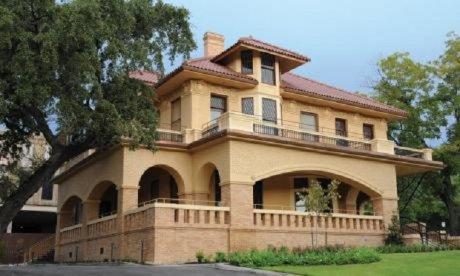Hidden Treasure

Byrne-Reed House after renovation.
Humanities Texas

Byrne-Reed House after renovation.
Humanities Texas
When looking for a new home to replace its cramped office condo in a suburban strip mall far from downtown Austin, Humanities Texas director, Michael Gillette, liked the location of the Texas Oil Company building, just blocks from the state capitoI. But while it had abundant space, access to parking, and a fair price, it was ugly: its cheap stucco façade was only surpassed by a bland interior. On an inside wall was a historic black-and-white photo of a spectacular old home and it turned out to be still there on the site, a brick mansion entombed beneath thick layers of stucco. Designed by one of the area’s most prominent architects, Charles H. Page, the Byrne-Reed House with its Prairie-style porches, art nouveau frieze, Mission-style terracotta roof tiles, and Richardsonian-Romanesque arches was a fine example of a style of architecture known as Texas eclectic. The mystique of having a century- old mansion that had been hidden for forty years and nobody knew existed was a story that could attract donors.
A million-dollar offer in federal funds from NEH, matched three-to-one in non-federal contributions, allowed Humanities Texas to pay off the mortgage and renovate the historic structure. For the first time since its inception in 1973, the Humanities Texas is able to host lectures, workshops, exhibits, and other public events in its own space. The restored Byrne-Reed House has had a powerful and transformative effect on every aspect of the council’s operations. It has dramatically increased the quantity and intellectual quality of humanities programming and allowed Humanities Texas to increase its financial base and raise its visibility with the rapid growth of the state and its increasingly diverse population.